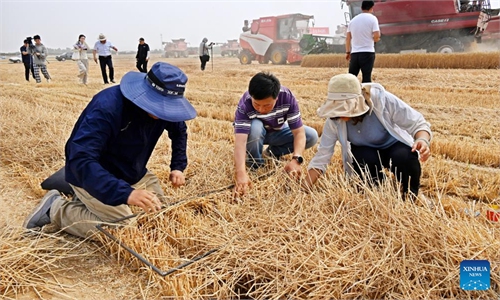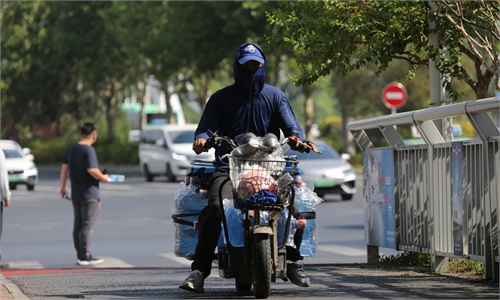Baking northern China consecutively records 40 C or above
Regions spare no effort combating drought, water shortage

Staff members of the State Grid Zaozhuang Power Supply Company in East China's Shandong Province conduct a maintenance tour on June 13, 2024 to ensure grid power supply amid an extreme heat wave. Photo: VCG
Over the past few days, northern China has been experiencing continuous high temperatures among other meteorological disasters. On Thursday, the high temperatures in the North China Plain and other areas remain at their peak, with some areas in North China's Hebei, Central China's Henan and East China's Shandong reporting temperatures exceeding 40 C, while Beijing is forecasted to break the record for the number of hot days in June. Under the continuous high temperatures, many areas are dealing with challenges such as drought and water shortages.
As of Thursday, the China Meteorological Administration (CMA) has been issuing high temperature warning for seven consecutive days. At 6 am Thursday, the CMA issued an orange high temperature warning, the second highest level in China's four-level warning system. According to the warning, some areas in Hebei, Shandong, Henan and other regions may reach 40 to 42 C or higher.
According to the CMA, the latest round of high temperatures in northern China are long lasting high ground temperatures . In areas such as Shanxi, Shaanxi, Henan, Hebei, and Shandong, the ground surface temperature may exceed 60 C during afternoon period, and in some areas, it may even exceed 70 C. The duration of high temperatures in a day may also reach eight hours or in some cases even above 10 hours.
Due to extreme hot weather, many regions have issued drought warnings. The latest meteorological drought monitoring shows that in Henan, 16 out of 18 cities and 72 national-level meteorological stations have monitored meteorological drought reaching severe levels or above.
The Ministry of Agriculture and Rural Affairs and the CMA jointly issued an agricultural high-temperature drought risk warning on Thursday. On the same day, the Ministry of Water Resources launched a level four emergency response for drought prevention in eight provinces including Hebei, Anhui and Shandong, and strengthened the scheduling of irrigation water sources, as the summer planting season across the country is already more than halfway through.
Yang Wentao, director of the Flood Control and Drought Relief Department of the Emergency Management Department of Henan Province, said that Henan is actively responding to the developing drought conditions, currently focusing on expanding the planting area, drought resistance and seedling protection. They are also working to carry out artificial rain enhancement operations when rainfall occurs, and aim to complete planting as soon as possible. Various departments have dispatched multiple work teams to guide drought resistance work in areas with severe drought conditions, he told the China Central Television.
Li Guoxiang, a research fellow from the Rural Development Institute of the Chinese Academy of Social Sciences, told the Global Times on Thursday that most northern regions are still in the summer planting stage, which is not greatly affected by high temperatures. However, if the high temperatures persist and the regions enter the autumn planting stage, drought may severely affect the planting.
Currently, China's irrigation system is relatively advanced, with professional systems and guidance personnel in place. If the drought persists, it is expected that large-scale irrigation will be used to minimize crop losses, Li said.
At the same time, in some other areas, high temperatures are accompanied by heavy rain, including Beijing. After experiencing short-lived thunderstorms over the past three days, Beijing's meteorological authority issued another lightning warning on Thursday, forecasting that Beijing will experience thunderstorms from Thursday afternoon to Friday morning.
On Wednesday, a weather observatory in Beijing recorded 36.3 C, marking the third hottest day of the summer this year. According to weather forecast, Beijing is likely to have more hot days than the average number of hot days in June (3.9 days). Meanwhile, Beijing has been experiencing thunderstorms for several days in a row, but they have not effectively lowered the daytime temperatures.
Frequent thunderstorms in North China in June are not uncommon, according to meteorologist Shi Yan from the China Weather Network, as quoted by the Xinhua News Agency.
"During the day, the sun scorches the earth, leading to temperatures above 35 C. The warm and humid air near the ground expands and rises, while cold air masses move southward. This creates a strong convective thunderstorm cloud formation. Despite the frequent thunderstorms, the weather system causing high temperatures remains unchanged, so the temperatures are not significantly affected," Shi said.
The broader context of global warming and anomalies in atmospheric circulation are direct factors contributing to high-temperature weather, Zheng Zhihai, chief forecaster at China's National Climate Center), told the Global Times.
According to Zheng, high-temperature weather appeared relatively earlier in China this summer, with more instances of high-temperature events.
With the occurrence of high temperatures in many parts of North China, many localities have advocated water conservation. Water shortages have been reported in some regions including Queshan in Henan, Pingliang in Gansu, and Pingyin in Shandong. At the same time, experts have warned of the potential pressure on the power supply system caused by the prolonged high temperatures.
Lin Boqiang, director of the China Center for Energy Economics Research at Xiamen University, told the Global Times on Thursday that the probability of a large-scale power and water supply crisis this summer is very low.
"Due to the extreme high temperatures, some regions across the two or three provinces may experience similar situations," he said. "Nonetheless, based on the current situation, susceptible regions have already made every effort to prepare for it."
Compared with major Western countries, the proportion of electricity and water consumption by residents in China is significantly lower, Li said.
"If there is pressure on energy supply during peak periods, the government could temporarily suspend factory production to ensure that household consumption is not affected. On that basis, residents do not need to worry about electricity and water issues," Lin said.



